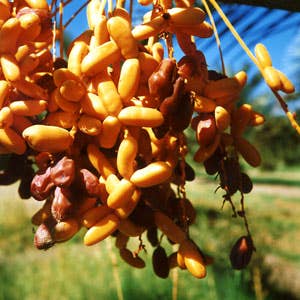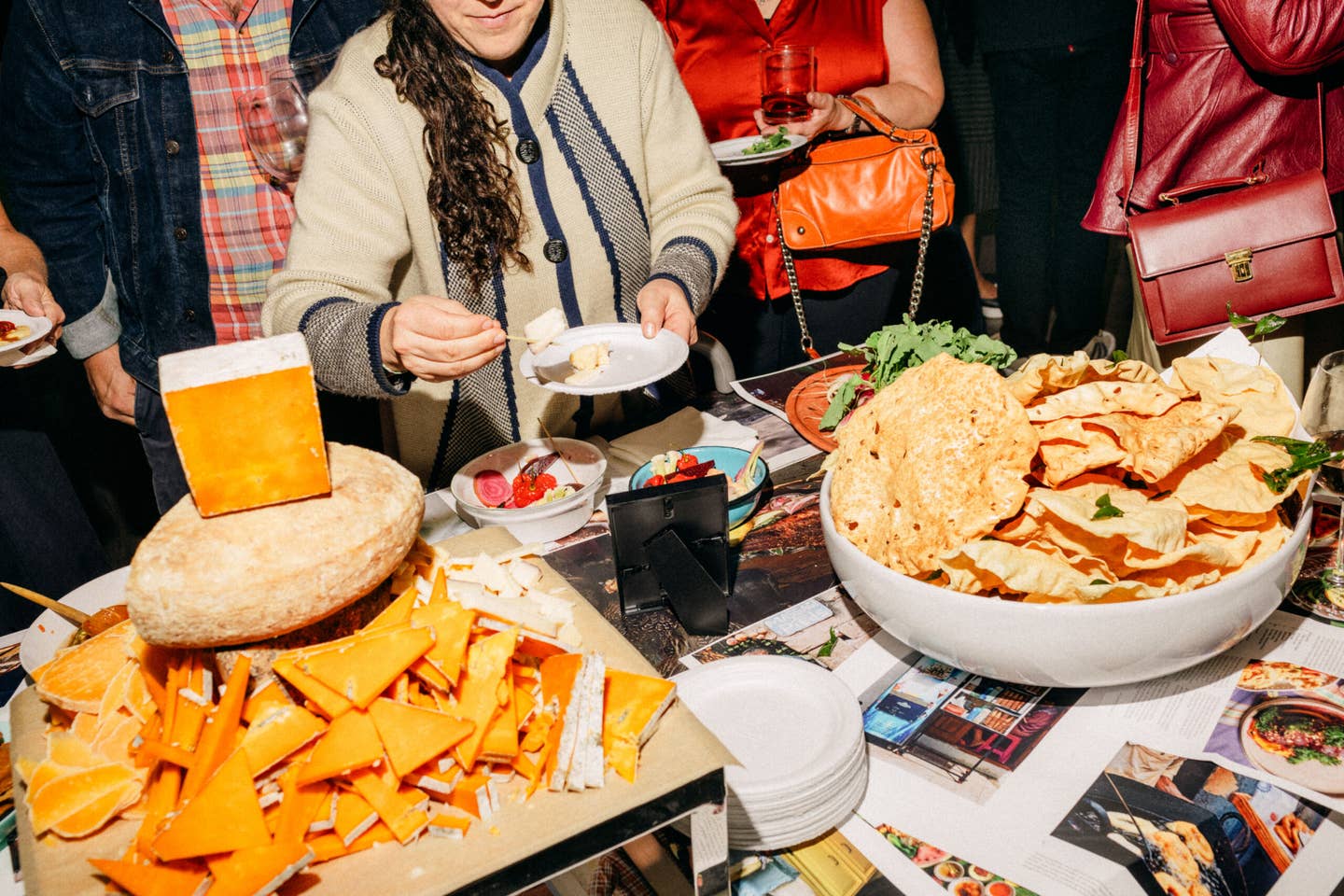
On the horizon, a dense grove of date palms suddenly appears, their leafy fronds blowing in the 95-degree wind. Then a row of signs flashes by my car window: free ice water…date shakes… medjools. Like countless parched travelers before me, I brake and turn in to the parking lot of the Oasis Date Gardens Ranch Store in the Coachella Valley town of Thermal, California, 135 miles southeast of Los Angeles. Established in 1912 by Ben and Lucy Laflin and today one of the top producers of premium (and organic) dates in America, Oasis is a cherished resource for lovers of this storied fruit.
My journey here began four years ago. Every winter, the Arab grocery stores in my Brooklyn neighborhood are crammed with cases of dates from Saudi Arabia, Algeria, and Tunisia. I'd never much cared for dates until one frosty day when a shopkeeper handed me a fat medjool as long as my thumb. Unlike the insipid supermarket dates I'd eaten before, it had a deep, rich taste reminiscent of caramel tinged with molasses and was meltingly soft. Even more surprising was the fact that the date was not from the Middle East but from California—specifically, Oasis Date Gardens. Since then, dates have become my preferred snack and dessert, so during a recent visit out West I made a point of visiting the company responsible.
While waiting to meet with Tim Burke, the operation's general manager (he has since left Oasis), I sip a sweet, creamy, cafe au lait-colored date shake, a Coachella Valley favorite, and marvel at the store's array of date breads, date muffins, date pies, date bars, and fresh dates (Oasis specializes in medjools but grows more than a dozen other varieties; see A World of Dates). When Burke—who is Ben Laflin Jr.'s son-in-law—arrives, he greets me with a cheery hello, then leads me to his battered Jeep Cherokee. Soon we're walking through the date palms on Oasis's nearby 175-acre farm. It is early October, the middle of harvest season, and heavy bunches of the fruit, covered with sheer mesh bags to protect them from insects and birds, sag from the trees. Their color ranges from yellow to dark brown. Burke explains that dates go through four stages of development, which are described in Arabic terms: kimri (young, hard, and green), khalal (of full size and, depending on the variety, yellow, pink, or red), rutab (soft and amber to light brown), and tamar (wrinkled and brown). Although a small market exists for the crunchy and astringent khalals and the gooey rutabs, prized by connoisseurs, more than 99 percent of the dates sold in this country are tamars, which have the most developed flavor and the longest shelf life.
Nearby, a group of palmeros, their heads swathed in bandanas, ascend into the palm fronds on platforms raised by forklift to pick medjools at the tamar stage. Date farming is a labor-intensive task that becomes more difficult the higher the palms get (they grow about a foot a year). According to Burke, at Oasis, palmeros climb each of the farm's 10,500 palms up to a dozen times a year. The work cycle starts in January, when the date thorns must be removed, and continues with the harvesting of pollen from the male trees (date palms are dioecious, meaning that there are both male trees and female ones), hand-pollinating the female flowers, thinning the bunches and removing excess leaves, covering each bunch, and gathering the fruit. They farm the palms until they reach about 60 feet; after that, the trees are retired.
The date palm, which thrives in oases and near large bodies of water (according to an old Arabic saying, it likes "its feet in water and its head in the fires of heaven"), is the original "tree of life", first cultivated at least 5,000 years ago in the Middle East and North Africa. Dates figure in many myths and religious accounts (Joseph and Mary ostensibly rested under a date palm during their flight into Egypt) and were the principal food of caravans and Bedouin nomads. It is said that Muhammad was told by God to eat dates during the month of Ramadan, and in honor of their Prophet, Muslims today traditionally break their fast during the holiday with the fruit.
More than 1,500 varieties of date grow in the world today, mainly in the belt of arid land that stretches from Morocco to India. In America, where about 30 types of the fruit are cultivated, the date industry is centered around the Coachella Valley and the Bard Valley, on the California-Arizona border. (The growing conditions in both places are similar to those in the deserts of the Middle East.) In 2002, the United States harvested 33 million pounds of dates, which accounts for less than 1 percent of the world's date production.
Ben Laflin Jr., now 81, took over the business from his father in 1950. In 1997, the family sold it to the owners of Winterhaven Ranch, a date producer in the Bard Valley, but Laflin still serves as an informal adviser at Oasis. Shy and laconic, except on the subject of dates, he gave me a capsule history of the farm: His father, an Illinois farm boy who attended the University of California at Berkeley, moved to Thermal in 1912 at the height of the great date boom. Three decades earlier, researchers from the U.S. Department of Agriculture had begun experimenting with date growing in the valley. A moderate amount of success with offshoots from North Africa and the Middle East was all it took for real-estate promoters to start touting the area as the newest place to make one's fortune. "Best Date Lands in the World," claimed one brochure. Laflin swallowed the bait. Shoots were expensive and took at least five years to bear fruit, and the date palms required a lot of nurturing. But like many others in the area, he persevered, and a new industry was created. By the 1920s, the date business had become divided between family farms like the Laflins' and big wholesalers, who concentrated on growing the deglet noor, best known in its role as the "supermarket" date. The tree is a heavy producer; its fruit is easily pitted by machines and can be picked when hard, then hydrated with steam before being shipped. The steam kills the deglet's delicate flavor, but this is considered no great loss, as the fruit is used mostly for cooking. Today deglet noors account for about 75 percent of the nation's yearly date crop.
The Laflins initially planted several date varieties, including the deglet noor. In the mid-1940s, though, they found the date that would become their primary product: the medjool. The plump, rich "Cadillac of dates", the medjool is native to Morocco, but the medjool trees there were almost eradicated by disease in the early 1900s. In 1927, Walter Swingle, a horticulturist with the USDA, came upon the last stand of healthy medjool palms in the Sahara and, with the blessing of the head sheik of the area, shipped 11 of their offshoots to America. They underwent quarantine and propagation, and 15 years later Laflin received one of the first allotments. The offshoots thrived in his soil, and when he sampled the fruit six years later, the luscious flavor and texture hooked him immediately.
Ben Jr., whose earliest job at Oasis when he was a child was to trap pocket gophers that dug holes in the irrigation ditches ("I got five cents a tail," he recalls), was working toward a master's degree in plant pathology at his father's alma mater when the medjools first bore fruit. He returned to Thermal with his wife, Pat, in 1950. Together, the pair started Oasis's mail-order business, moved the ranch store from a shack behind Ben Sr.'s small adobe house to its current location, and turned the farm into the third-largest medjool producer in the country—without sacrificing their reputation for quality. Along the way, Ben Jr. became a leading expert on date propagation.
The industry has changed a lot since his father planted his first date palm, says Laflin. (Most recently, growers are finding that their trees are often worth more as ornamentals.) But, he adds, one truth is timeless: "A well-kept date garden is a majestic sight."
Keep Reading
Continue to Next Story










